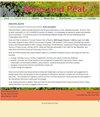Peat Use in Horticulture
IF 1.5
4区 环境科学与生态学
Q4 ENVIRONMENTAL SCIENCES
引用次数: 17
Abstract
Peat is a spongy substance which is an effect of incomplete decomposition of plant residues in different stages of decomposition. Between the several organic matters which are used as substrate for horticultural plants cultivation in soilless conditions, peat is the unabandonable ingredient for mixtures for commercial production of plants. Peat is used in horticulture as a component of garden plant substrates, in agriculture for the production of garden soil and as an organic fertilizer, and in balneology as a material for baths and wraps. The use of peat for agriculture and horticulture is determined by the following quality parameters: the degree of decomposition, ash content, pH, the presence of carbonates, the density of the solid phase, bulk density, and porosity. As an organic material, the peat forms in the acidic, waterlogged, and sterile conditions of fens and bogs. The conditions seem like the development of mosses. The plants do not compose as they die. Instead of this, the organic matter is laid down and accumulates in a slow time as peat due to the oxygen deficiency in the bog. This makes peat a highly productive growing medium. In the present novel review, we discuss the peat use in horticulture.泥炭在园艺中的应用
泥炭是一种海绵状物质,是植物残体在不同分解阶段不完全分解的产物。在无土条件下用作园艺植物栽培基质的几种有机物中,泥炭是用于植物商业生产的混合物中不可放弃的成分。泥炭在园艺中用作园林植物基质的组成部分,在农业中用作园林土壤的生产和有机肥料,在园艺中用作浴盆和覆盖物的材料。泥炭用于农业和园艺是由以下质量参数决定的:分解程度、灰分含量、pH值、碳酸盐的存在、固相密度、体积密度和孔隙度。作为一种有机物质,泥炭是在沼泽和沼泽的酸性、浸水和无菌条件下形成的。这里的环境就像苔藓的生长。植物死后不会合成。相反,由于沼泽缺氧,有机物质被放置并以泥炭的形式在缓慢的时间内积累。这使泥炭成为一种高产的生长介质。本文就泥炭在园艺中的应用作一综述。
本文章由计算机程序翻译,如有差异,请以英文原文为准。
求助全文
约1分钟内获得全文
求助全文
来源期刊

Mires and Peat
ENVIRONMENTAL SCIENCES-
CiteScore
2.30
自引率
16.70%
发文量
0
审稿时长
33 weeks
期刊介绍:
Mires and Peat is a peer-reviewed internet journal focusing specifically on mires, peatlands and peat. As a truly “free-to-users” publication (i.e. NO CHARGES to authors OR readers), it is immediately accessible to readers and potential authors worldwide. It is published jointly by the International Peatland Society (IPS) and the International Mire Conservation Group (IMCG).
Mires and Peat is indexed by Thomson Reuters Web of Science (2017 Impact Factors: 1.326 [two-year] and 1.638 [five-year]), Elsevier Scopus, EBSCO Environment Complete, CABI Abstracts, CSA Proquest (including their Aquatic Science and Fisheries Abstracts ASFA, Ecology, Entomology, Animal Behavior, Aqualine and Pollution databases) and Directory of Open Access Journals (DOAJ). Mires and Peat also participates in the CABI Full Text Repository, and subscribes to the Portico E-journal Preservation Service (LTPA).
Mires and Peat publishes high-quality research papers on all aspects of peatland science, technology and wise use, including:
ecology, hydrology, survey, inventory, classification, functions and values of mires and peatlands;
scientific, economic and human aspects of the management of peatlands for agriculture, forestry, nature conservation, environmental protection, peat extraction, industrial development and other purposes;
biological, physical and chemical characteristics of peat; and
climate change and peatlands.
Short communications and review articles on these and related topics will also be considered; and suggestions for special issues of the Journal based on the proceedings of conferences, seminars, symposia and workshops will be welcomed. The submission of material by authors and from countries whose work would otherwise be inaccessible to the international community is particularly encouraged.
 求助内容:
求助内容: 应助结果提醒方式:
应助结果提醒方式:


